MITSUBISHI ASX 2014 Owner's Manual (in English)
Manufacturer: MITSUBISHI, Model Year: 2014, Model line: ASX, Model: MITSUBISHI ASX 2014Pages: 418, PDF Size: 14.02 MB
Page 181 of 418
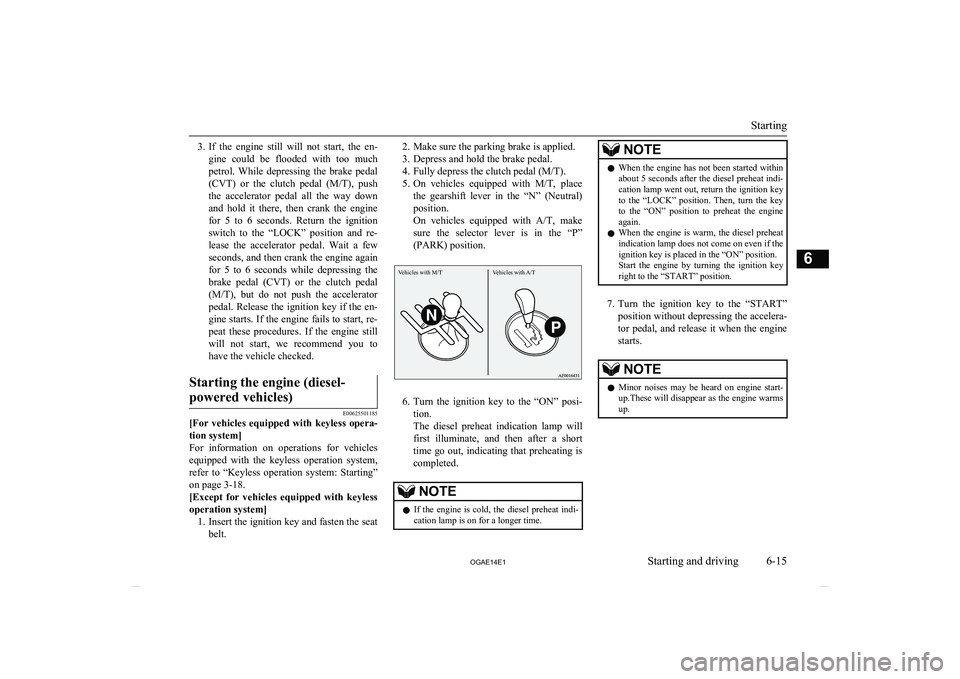
3.If the engine still will not start, the en-
gine could be flooded with too much petrol. While depressing the brake pedal
(CVT ) or the clutch pedal ( M/T), push
the accelerator pedal all the way down
and hold it there, then crank the engine for 5 to 6 seconds. Return the ignition
switch to the “LOCK” position and re- lease the accelerator pedal. Wait a fewseconds, and then crank the engine again
for 5 to 6 seconds while depressing the
brake pedal ( CVT) or the clutch pedal
(M/T ), but do not push the accelerator
pedal. Release the ignition key if the en-
gine starts. If the engine fails to start, re- peat these procedures. If the engine still will not start, we recommend you to
have the vehicle checked.Starting the engine (diesel-
powered vehicles)
E00625501185
[For vehicles equipped with keyless opera- tion system]
For information on operations for vehicles equipped with the keyless operation system,
refer to “Keyless operation system: Starting”
on page 3-18.
[Except for vehicles equipped with keyless operation system] 1. Insert the ignition key and fasten the seat
belt.
2. Make sure the parking brake is applied.
3. Depress and hold the brake pedal.
4. Fully depress the clutch pedal (M/T).
5. On vehicles equipped with M/T, place
the gearshift lever in the “N” (Neutral)
position.
On vehicles equipped with A/T, make
sure the selector lever is in the “P”
(PARK) position.
6. Turn the ignition key to the “ON” posi-
tion.
The diesel preheat indication lamp will
first illuminate, and then after a short
time go out, indicating that preheating is completed.
NOTEl If the engine is cold, the diesel preheat indi-
cation lamp is on for a longer time.NOTEl When the engine has not been started within
about 5 seconds after the diesel preheat indi- cation lamp went out, return the ignition key
to the “LOCK” position. Then, turn the key
to the “ON” position to preheat the engine again.
l When the engine is warm, the diesel preheat
indication lamp does not come on even if the
ignition key is placed in the “ON” position.
Start the engine by turning the ignition key
right to the “START” position.
7. Turn the ignition key to the “START”
position without depressing the accelera- tor pedal, and release it when the engine
starts.
NOTEl Minor noises may be heard on engine start-
up.These will disappear as the engine warms
up.
Starting
6-15
OGAE14E1Starting and driving6Vehicles with M/T Vehicles with A/T
Page 182 of 418
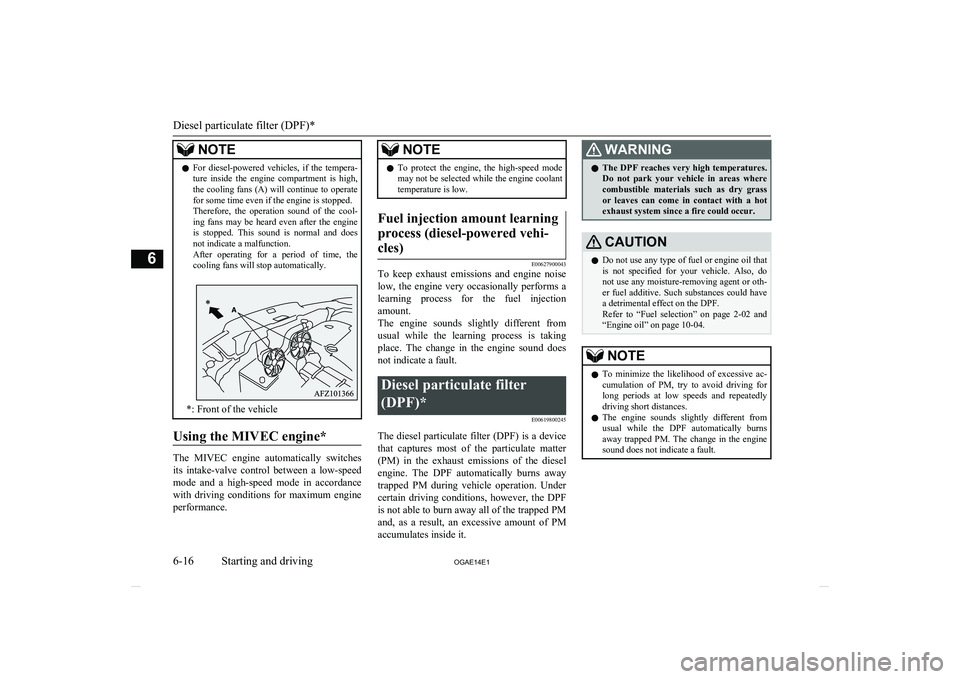
NOTElFor diesel-powered vehicles, if the tempera-
ture inside the engine compartment is high,
the cooling fans (A) will continue to operate for some time even if the engine is stopped.
Therefore, the operation sound of the cool-
ing fans may be heard even after the engine is stopped. This sound is normal and does
not indicate a malfunction.
After operating for a period of time, the cooling fans will stop automatically.
*: Front of the vehicle
Using the MIVEC engine*
The MIVEC engine automatically switches
its intake-valve control between a low-speed mode and a high-speed mode in accordancewith driving conditions for maximum engine
performance.
NOTEl To protect the engine, the high-speed mode
may not be selected while the engine coolanttemperature is low.Fuel injection amount learning
process (diesel-powered vehi- cles)
E00627900043
To keep exhaust emissions and engine noise low, the engine very occasionally performs a
learning process for the fuel injection
amount.
The engine sounds slightly different from
usual while the learning process is taking place. The change in the engine sound does
not indicate a fault.
Diesel particulate filter
(DPF)* E00619800245
The diesel particulate filter (DPF) is a devicethat captures most of the particulate matter
(PM) in the exhaust emissions of the diesel engine. The DPF automatically burns away trapped PM during vehicle operation. Under
certain driving conditions, however, the DPF is not able to burn away all of the trapped PM
and, as a result, an excessive amount of PM accumulates inside it.
WARNINGl The DPF reaches very high temperatures.
Do not park your vehicle in areas where
combustible materials such as dry grass
or leaves can come in contact with a hot exhaust system since a fire could occur.CAUTIONl Do not use any type of fuel or engine oil that
is not specified for your vehicle. Also, do not use any moisture-removing agent or oth-
er fuel additive. Such substances could have a detrimental effect on the DPF.
Refer to “Fuel selection” on page 2-02 and
“Engine oil” on page 10-04.NOTEl To minimize the likelihood of excessive ac-
cumulation of PM, try to avoid driving for long periods at low speeds and repeatedly
driving short distances.
l The engine sounds slightly different from
usual while the DPF automatically burns
away trapped PM. The change in the engine
sound does not indicate a fault.
Diesel particulate filter (DPF)*
6-16 OGAE14E1Starting and driving6
Page 183 of 418
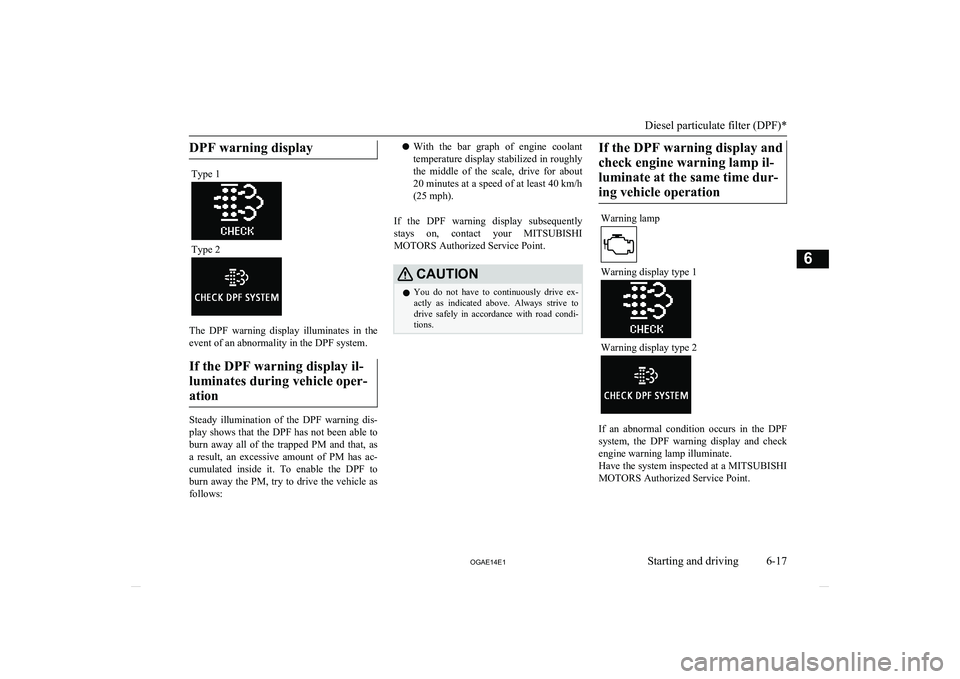
DPF warning displayType 1
Type 2
The DPF warning display illuminates in the
event of an abnormality in the DPF system.
If the DPF warning display il-luminates during vehicle oper-ation
Steady illumination of the DPF warning dis- play shows that the DPF has not been able to
burn away all of the trapped PM and that, as
a result, an excessive amount of PM has ac- cumulated inside it. To enable the DPF toburn away the PM, try to drive the vehicle as
follows:
l With the bar graph of engine coolant
temperature display stabilized in roughly
the middle of the scale, drive for about 20 minutes at a speed of at least 40 km/h
(25 mph).
If the DPF warning display subsequently stays on, contact your MITSUBISHI
MOTORS Authorized Service Point.CAUTIONl You do not have to continuously drive ex-
actly as indicated above. Always strive to drive safely in accordance with road condi- tions.If the DPF warning display and
check engine warning lamp il-luminate at the same time dur-ing vehicle operationWarning lamp
Warning display type 1
Warning display type 2
If an abnormal condition occurs in the DPF system, the DPF warning display and check
engine warning lamp illuminate.
Have the system inspected at a MITSUBISHI
MOTORS Authorized Service Point.
Diesel particulate filter (DPF)*
6-17
OGAE14E1Starting and driving6
Page 184 of 418
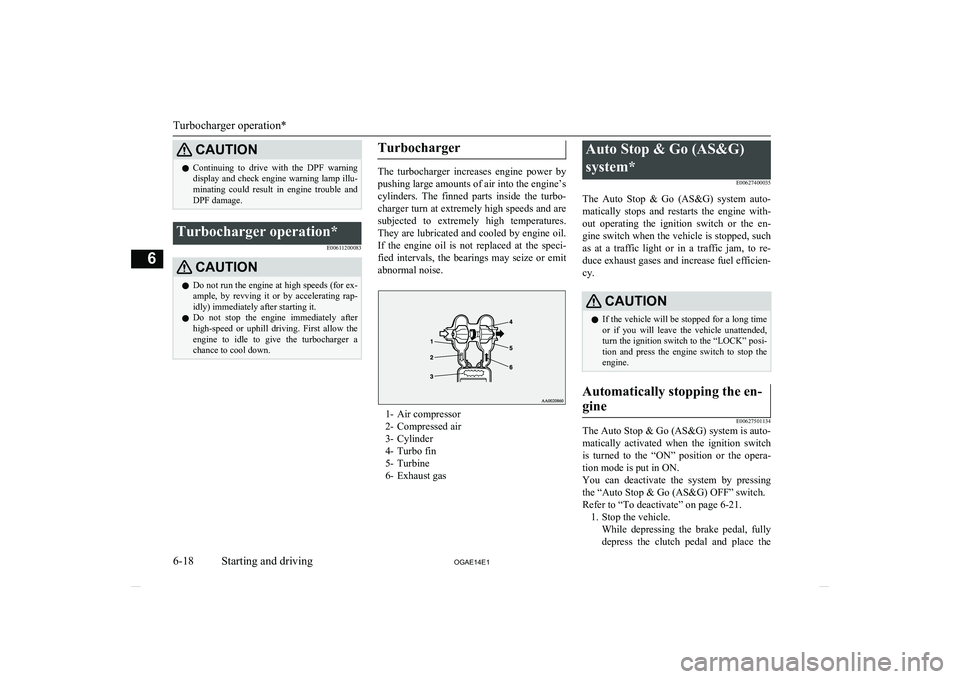
CAUTIONlContinuing to drive with the DPF warning
display and check engine warning lamp illu- minating could result in engine trouble and
DPF damage.Turbocharger operation*
E00611200083CAUTIONlDo not run the engine at high speeds (for ex-
ample, by revving it or by accelerating rap-
idly) immediately after starting it.
l Do not stop the engine immediately after
high-speed or uphill driving. First allow the
engine to idle to give the turbocharger a
chance to cool down.Turbocharger
The turbocharger increases engine power by
pushing large amounts of air into the engine’s
cylinders. The finned parts inside the turbo- charger turn at extremely high speeds and aresubjected to extremely high temperatures.
They are lubricated and cooled by engine oil.
If the engine oil is not replaced at the speci- fied intervals, the bearings may seize or emit
abnormal noise.
1- Air compressor
2- Compressed air
3- Cylinder
4- Turbo fin
5- Turbine
6- Exhaust gas
Auto Stop & Go (AS&G)
system* E00627400035
The Auto Stop & Go (AS&G) system auto- matically stops and restarts the engine with- out operating the ignition switch or the en-gine switch when the vehicle is stopped, such
as at a traffic light or in a traffic jam, to re- duce exhaust gases and increase fuel efficien- cy.CAUTIONl If the vehicle will be stopped for a long time
or if you will leave the vehicle unattended,
turn the ignition switch to the “LOCK” posi-
tion and press the engine switch to stop the
engine.Automatically stopping the en-
gine
E00627501134
The Auto Stop & Go (AS&G) system is auto- matically activated when the ignition switch is turned to the “ON” position or the opera-
tion mode is put in ON.
You can deactivate the system by pressing the “Auto Stop & Go (AS&G) OFF” switch.
Refer to “To deactivate” on page 6-21. 1. Stop the vehicle. While depressing the brake pedal, fullydepress the clutch pedal and place the
Turbocharger operation*
6-18 OGAE14E1Starting and driving6
Page 185 of 418
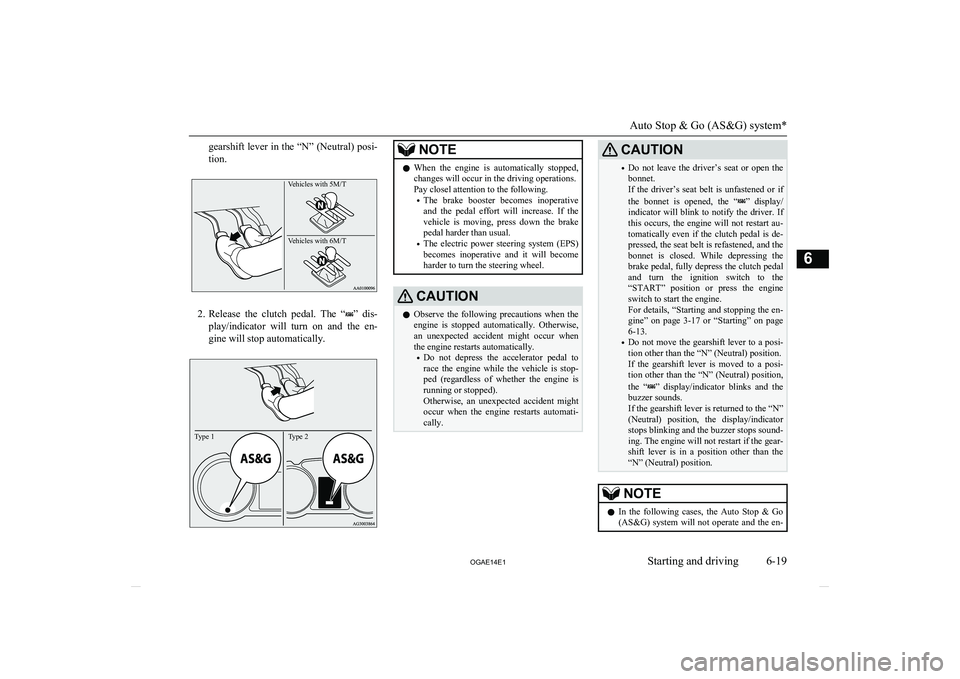
gearshift lever in the “N” (Neutral) posi-
tion.Vehicles with 5M/T Vehicles with 6M/T
2. Release the clutch pedal. The “” dis-
play/indicator will turn on and the en- gine will stop automatically.
Type 1Type 2
NOTEl When the engine is automatically stopped,
changes will occur in the driving operations.
Pay closel attention to the following.
• The brake booster becomes inoperative
and the pedal effort will increase. If the
vehicle is moving, press down the brake pedal harder than usual.
• The electric power steering system (EPS)
becomes inoperative and it will become
harder to turn the steering wheel.CAUTIONl Observe the following precautions when the
engine is stopped automatically. Otherwise,
an unexpected accident might occur when the engine restarts automatically.
• Do not depress the accelerator pedal to
race the engine while the vehicle is stop-
ped (regardless of whether the engine is running or stopped).
Otherwise, an unexpected accident might
occur when the engine restarts automati- cally.CAUTION• Do not leave the driver’s seat or open the
bonnet.
If the driver’s seat belt is unfastened or if
the bonnet is opened, the “
” display/
indicator will blink to notify the driver. If
this occurs, the engine will not restart au- tomatically even if the clutch pedal is de- pressed, the seat belt is refastened, and thebonnet is closed. While depressing the
brake pedal, fully depress the clutch pedal
and turn the ignition switch to the
“START” position or press the engine switch to start the engine.
For details, “Starting and stopping the en-
gine” on page 3-17 or “Starting” on page
6-13.
• Do not move the gearshift lever to a posi-
tion other than the “N” (Neutral) position.
If the gearshift lever is moved to a posi-
tion other than the “N” (Neutral) position,
the “
” display/indicator blinks and the
buzzer sounds.
If the gearshift lever is returned to the “N”
(Neutral) position, the display/indicator
stops blinking and the buzzer stops sound- ing. The engine will not restart if the gear-
shift lever is in a position other than the “N” (Neutral) position.
NOTEl In the following cases, the Auto Stop & Go
(AS&G) system will not operate and the en-
Auto Stop & Go (AS&G) system*
6-19
OGAE14E1Starting and driving6
Page 186 of 418
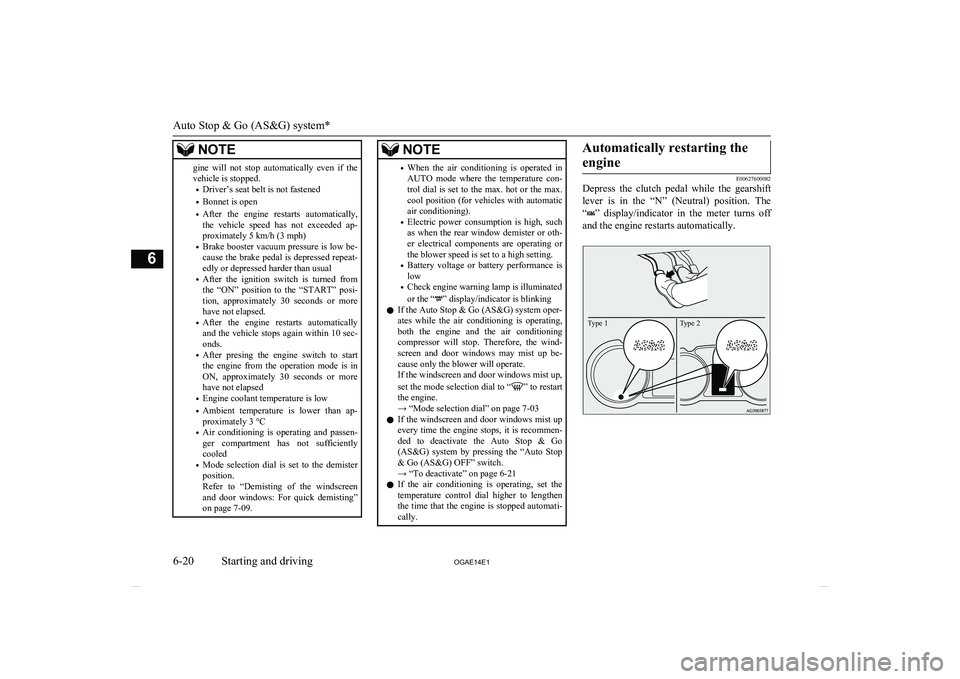
NOTEgine will not stop automatically even if thevehicle is stopped.
• Driver’s seat belt is not fastened
• Bonnet is open
• After the engine restarts automatically,
the vehicle speed has not exceeded ap- proximately 5 km/h (3 mph)
• Brake booster vacuum pressure is low be-
cause the brake pedal is depressed repeat-
edly or depressed harder than usual
• After the ignition switch is turned from
the “ON” position to the “START” posi-
tion, approximately 30 seconds or more
have not elapsed.
• After the engine restarts automatically
and the vehicle stops again within 10 sec- onds.
• After presing the engine switch to start
the engine from the operation mode is in ON, approximately 30 seconds or morehave not elapsed
• Engine coolant temperature is low
• Ambient temperature is lower than ap-
proximately 3 °C
• Air conditioning is operating and passen-
ger compartment has not sufficiently cooled
• Mode selection dial is set to the demister
position.
Refer to “Demisting of the windscreen
and door windows: For quick demisting”
on page 7-09.NOTE• When the air conditioning is operated in
AUTO mode where the temperature con- trol dial is set to the max. hot or the max.
cool position (for vehicles with automatic air conditioning).
• Electric power consumption is high, such
as when the rear window demister or oth- er electrical components are operating or
the blower speed is set to a high setting.
• Battery voltage or battery performance is
low
• Check engine warning lamp is illuminated
or the “
” display/indicator is blinking
l If the Auto Stop & Go (AS&G) system oper-
ates while the air conditioning is operating, both the engine and the air conditioning
compressor will stop. Therefore, the wind- screen and door windows may mist up be-
cause only the blower will operate.
If the windscreen and door windows mist up,
set the mode selection dial to “
” to restart
the engine.
→ “Mode selection dial” on page 7-03
l If the windscreen and door windows mist up
every time the engine stops, it is recommen-
ded to deactivate the Auto Stop & Go
(AS&G) system by pressing the “Auto Stop & Go (AS&G) OFF” switch.
→ “To deactivate” on page 6-21
l If the air conditioning is operating, set the
temperature control dial higher to lengthen
the time that the engine is stopped automati- cally.
Automatically restarting the
engine
E00627600082
Depress the clutch pedal while the gearshift
lever is in the “N” (Neutral) position. The
“
” display/indicator in the meter turns off
and the engine restarts automatically.
Type 2Type 1
Auto Stop & Go (AS&G) system*
6-20 OGAE14E1Starting and driving6
Page 187 of 418
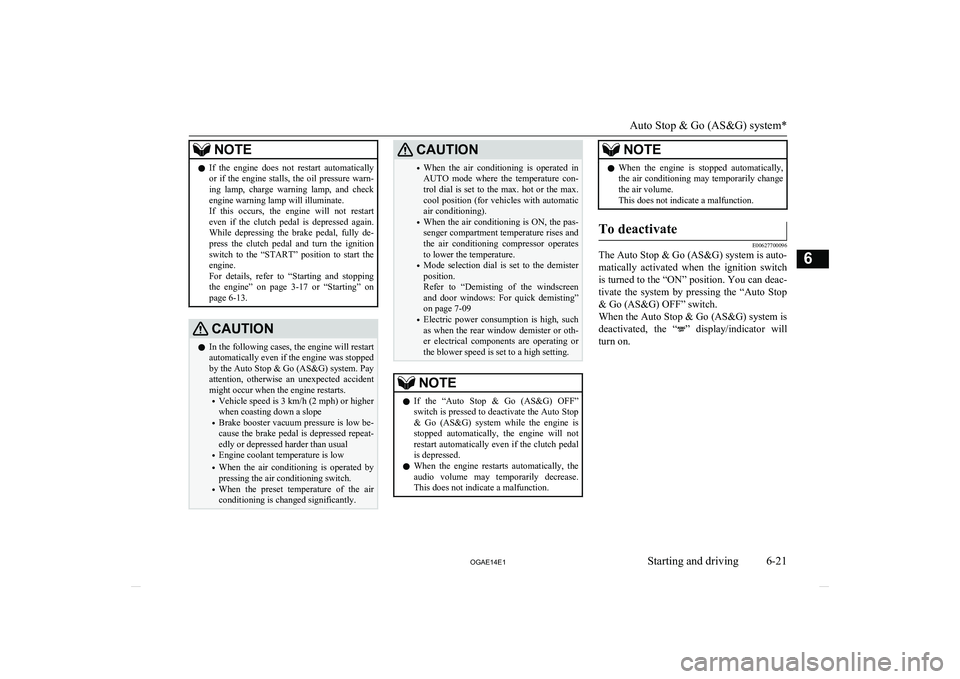
NOTElIf the engine does not restart automatically
or if the engine stalls, the oil pressure warn- ing lamp, charge warning lamp, and check
engine warning lamp will illuminate.
If this occurs, the engine will not restart even if the clutch pedal is depressed again. While depressing the brake pedal, fully de-
press the clutch pedal and turn the ignition switch to the “START” position to start theengine.
For details, refer to “Starting and stopping
the engine” on page 3-17 or “Starting” on
page 6-13.CAUTIONl In the following cases, the engine will restart
automatically even if the engine was stopped
by the Auto Stop & Go (AS&G) system. Pay attention, otherwise an unexpected accidentmight occur when the engine restarts.
• Vehicle speed is 3 km/h (2 mph) or higher
when coasting down a slope
• Brake booster vacuum pressure is low be-
cause the brake pedal is depressed repeat-
edly or depressed harder than usual
• Engine coolant temperature is low
• When the air conditioning is operated by
pressing the air conditioning switch.
• When the preset temperature of the air
conditioning is changed significantly.CAUTION• When the air conditioning is operated in
AUTO mode where the temperature con- trol dial is set to the max. hot or the max.
cool position (for vehicles with automatic air conditioning).
• When the air conditioning is ON, the pas-
senger compartment temperature rises and
the air conditioning compressor operates to lower the temperature.
• Mode selection dial is set to the demister
position.
Refer to “Demisting of the windscreen and door windows: For quick demisting”
on page 7-09
• Electric power consumption is high, such
as when the rear window demister or oth- er electrical components are operating or
the blower speed is set to a high setting.NOTEl If the “Auto Stop & Go (AS&G) OFF”
switch is pressed to deactivate the Auto Stop
& Go (AS&G) system while the engine is
stopped automatically, the engine will not restart automatically even if the clutch pedal
is depressed.
l When the engine restarts automatically, the
audio volume may temporarily decrease. This does not indicate a malfunction.NOTEl When the engine is stopped automatically,
the air conditioning may temporarily change
the air volume.
This does not indicate a malfunction.To deactivate
E00627700096
The Auto Stop & Go (AS&G) system is auto-
matically activated when the ignition switch is turned to the “ON” position. You can deac-
tivate the system by pressing the “Auto Stop & Go (AS&G) OFF” switch.
When the Auto Stop & Go (AS&G) system is deactivated, the “
” display/indicator will
turn on.
Auto Stop & Go (AS&G) system*
6-21
OGAE14E1Starting and driving6
Page 188 of 418
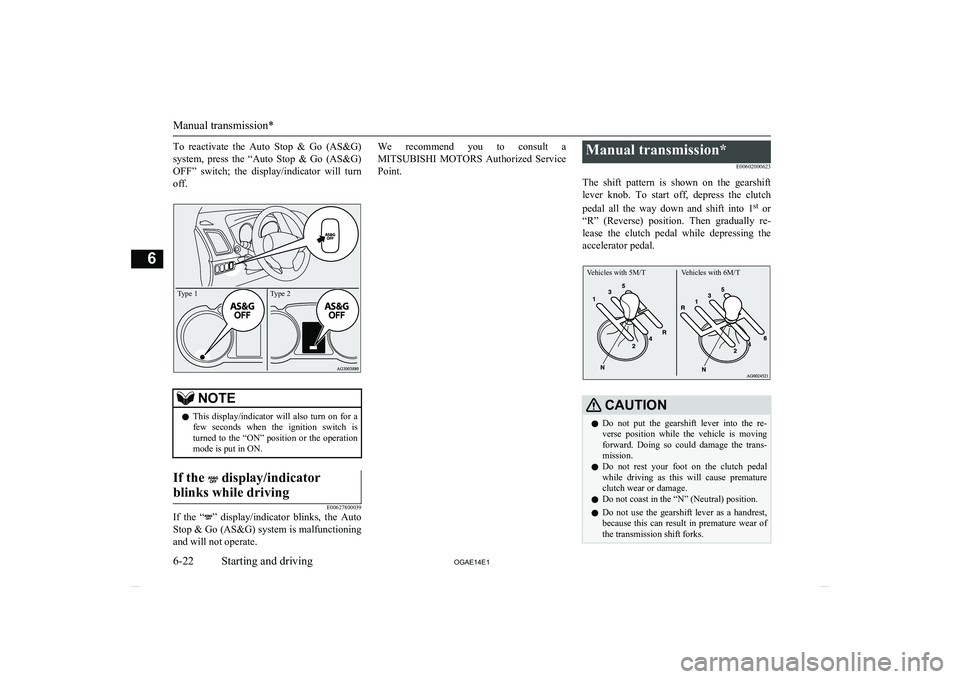
To reactivate the Auto Stop & Go (AS&G)system, press the “Auto Stop & Go (AS&G)
OFF” switch; the display/indicator will turn
off.Type 1Type 2
NOTEl This display/indicator will also turn on for a
few seconds when the ignition switch isturned to the “ON” position or the operationmode is put in ON.If the display/indicator
blinks while driving
E00627800039
If the “” display/indicator blinks, the Auto
Stop & Go (AS&G) system is malfunctioning
and will not operate.
We recommend you to consult a
MITSUBISHI MOTORS Authorized Service
Point.Manual transmission*
E00602000623
The shift pattern is shown on the gearshift lever knob. To start off, depress the clutch
pedal all the way down and shift into 1 st
or
“R” (Reverse) position. Then gradually re- lease the clutch pedal while depressing the
accelerator pedal.
Vehicles with 5M/TVehicles with 6M/T
CAUTIONl Do not put the gearshift lever into the re-
verse position while the vehicle is moving forward. Doing so could damage the trans-mission.
l Do not rest your foot on the clutch pedal
while driving as this will cause premature clutch wear or damage.
l Do not coast in the “N” (Neutral) position.
l Do not use the gearshift lever as a handrest,
because this can result in premature wear of
the transmission shift forks.
Manual transmission*
6-22 OGAE14E1Starting and driving6
Page 189 of 418
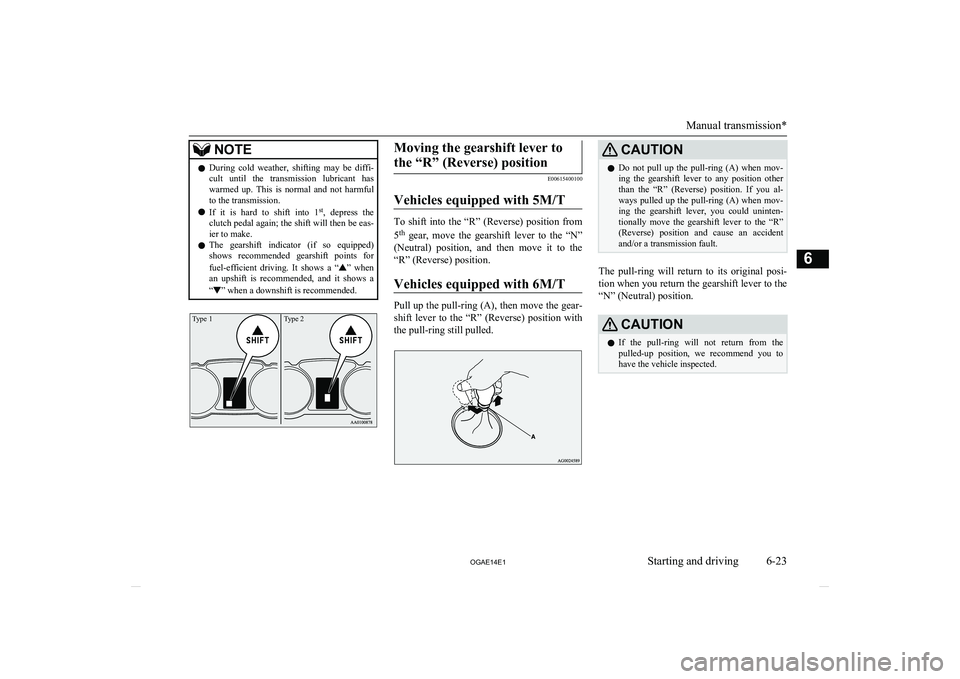
NOTElDuring cold weather, shifting may be diffi-
cult until the transmission lubricant has
warmed up. This is normal and not harmful
to the transmission.
l If it is hard to shift into 1 st
, depress the
clutch pedal again; the shift will then be eas-
ier to make.
l The gearshift indicator (if so equipped)
shows recommended gearshift points for
fuel-efficient driving. It shows a “
” when
an upshift is recommended, and it shows a
“
” when a downshift is recommended.
Type 2Type 1Moving the gearshift lever to
the “R” (Reverse) position
E00615400100
Vehicles equipped with 5M/T
To shift into the “R” (Reverse) position from
5 th
gear, move the gearshift lever to the “N”
(Neutral) position, and then move it to the “R” (Reverse) position.
Vehicles equipped with 6M/T
Pull up the pull-ring (A), then move the gear-
shift lever to the “R” (Reverse) position with the pull-ring still pulled.
CAUTIONl Do not pull up the pull-ring (A) when mov-
ing the gearshift lever to any position other than the “R” (Reverse) position. If you al-
ways pulled up the pull-ring (A) when mov- ing the gearshift lever, you could uninten- tionally move the gearshift lever to the “R”
(Reverse) position and cause an accident and/or a transmission fault.
The pull-ring will return to its original posi-
tion when you return the gearshift lever to the“N” (Neutral) position.
CAUTIONl If the pull-ring will not return from the
pulled-up position, we recommend you to
have the vehicle inspected.
Manual transmission*
6-23
OGAE14E1Starting and driving6
Page 190 of 418
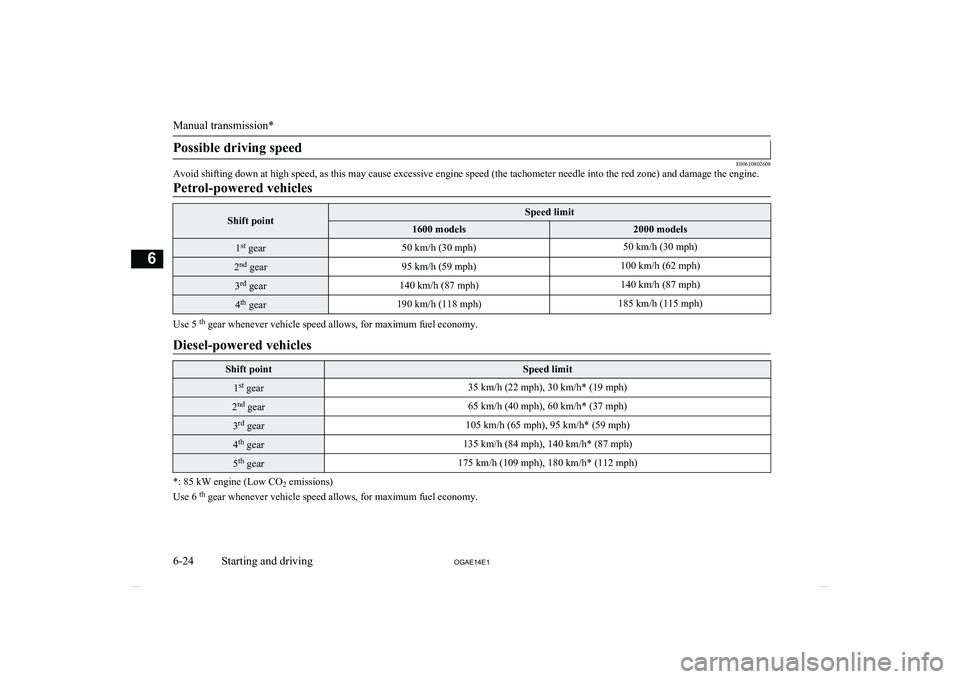
Possible driving speed
E00610802608
Avoid shifting down at high speed, as this may cause excessive engine speed (the tachometer needle into the red zone) and damage the engine.
Petrol-powered vehiclesShift pointSpeed limit1600 models2000 models1 st
gear50 km/h (30 mph)50 km/h (30 mph)2nd
gear95 km/h (59 mph)100 km/h (62 mph)3rd
gear140 km/h (87 mph)140 km/h (87 mph)4th
gear190 km/h (118 mph)185 km/h (115 mph)
Use 5 th
gear whenever vehicle speed allows, for maximum fuel economy.
Diesel-powered vehiclesShift pointSpeed limit1st
gear35 km/h (22 mph), 30 km/h* (19 mph)2nd
gear65 km/h (40 mph), 60 km/h* (37 mph)3rd
gear105 km/h (65 mph), 95 km/h* (59 mph)4th
gear135 km/h (84 mph), 140 km/h* (87 mph)5th
gear175 km/h (109 mph), 180 km/h* (112 mph)
*: 85 kW engine (Low CO 2 emissions)
Use 6 th
gear whenever vehicle speed allows, for maximum fuel economy.
Manual transmission*
6-24 OGAE14E1Starting and driving6